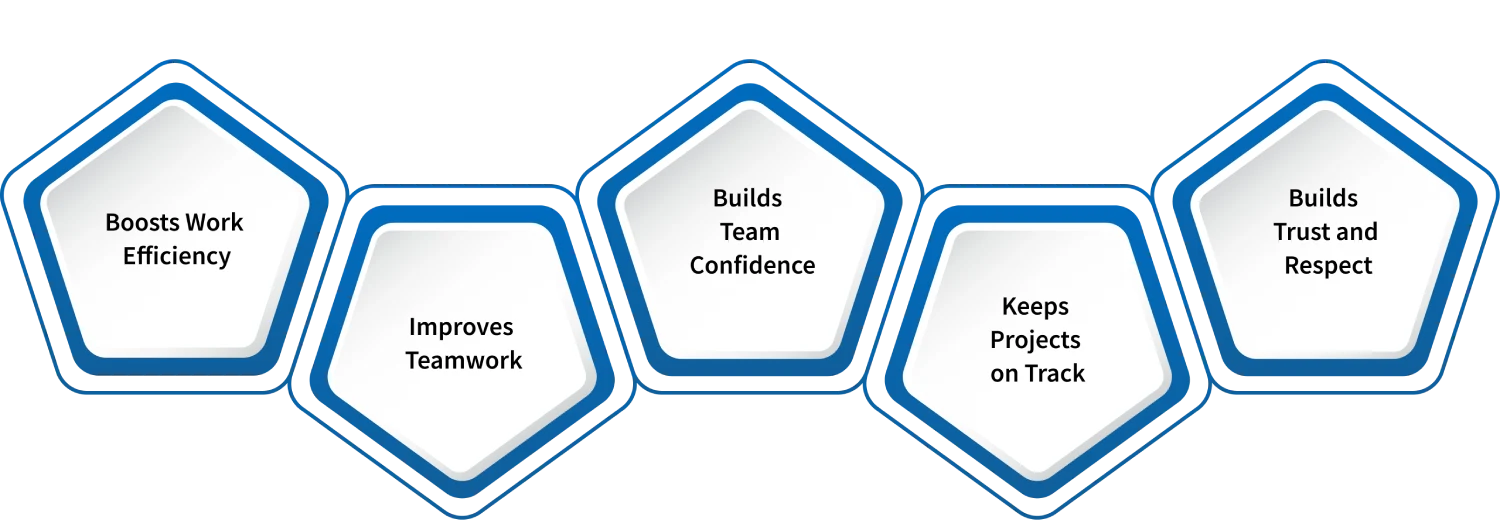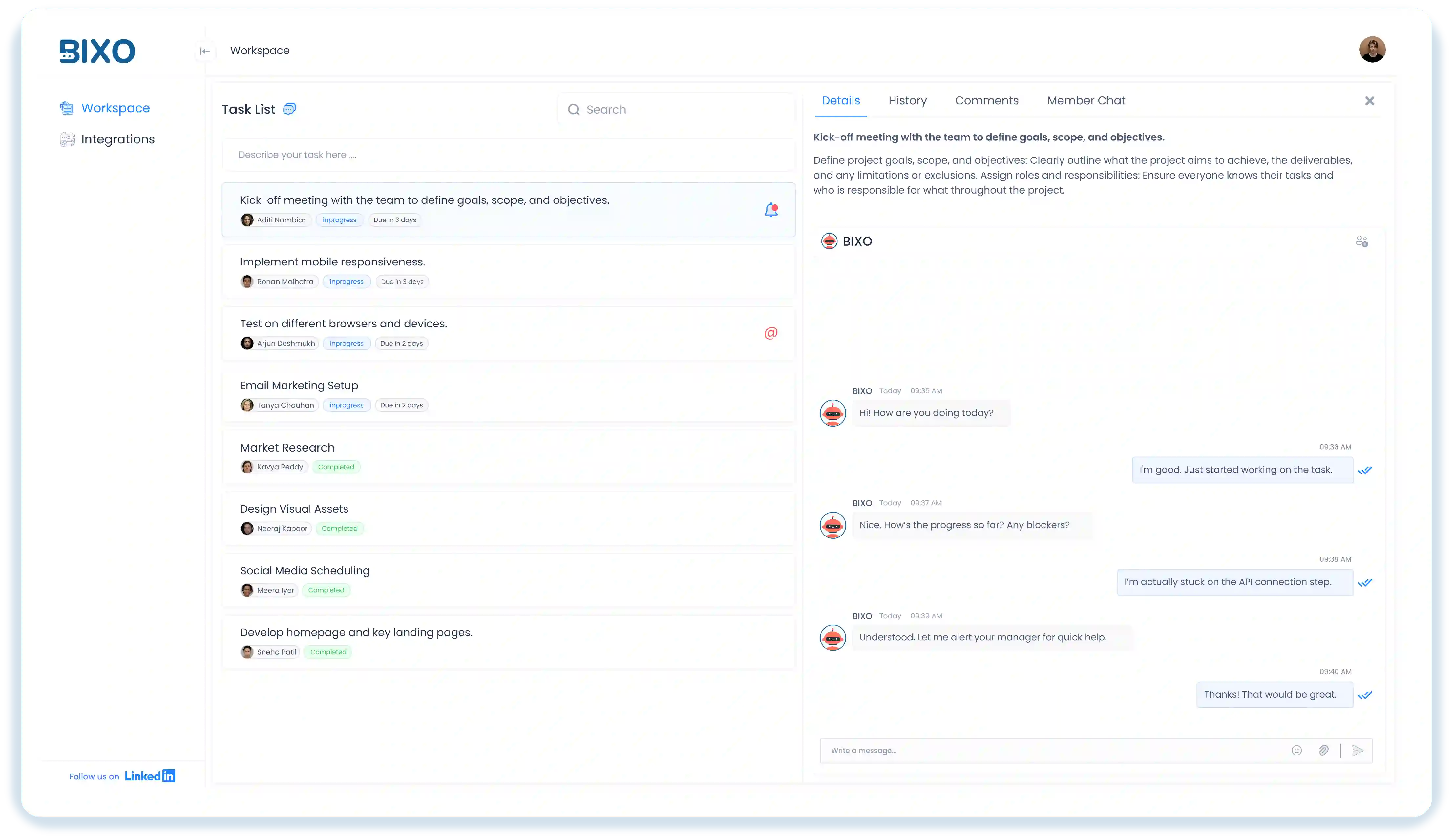
Table of Content
Focus on what matters. BIXO handles the rest!

When communication between your team members is really good, tasks get done faster, everybody knows their role, and confusion is less. However, that is not generally the case. We miss messages, feedback does not land the right way, and collaboration slows down. That’s why learning ways to improve communication in teams is important.
Whether you are checking in on daily tasks or working on bigger objectives, clear communication helps everyone remain aligned. In this blog, you will find simple ways to improve team communication at work and work together better every day.
What is Team Communication?
Team communication is how people in a team share ideas, updates, and information to get things done. It covers quick chats, messages, emails, meetings, and even how people listen and reply. When communication is clear, work moves faster, there’s less confusion, and everyone knows what’s going on.
It’s not just about saying more. It’s about making sure the right message reaches the right person at the right time. No matter where your team works, whether from home, the office, or in a hybrid setup, good communication keeps everything on track.
What Is the Importance of Effective Communication in Teams?
When your team communicates well, work becomes easier. Everyone understands what’s going on, stays focused, and solves problems faster. But if communication isn’t clear, things start to slow down. Deadlines get missed, stress increases, and small problems turn into bigger ones. That’s why good team communication isn’t just nice to have, it’s a must.
Here’s how strong communication really helps your team:

Boosts Work Efficiency
When instructions are clear and updates are easy to follow, teams do not waste time asking the same questions or correcting avoidable mistakes. Everyone realises what they're supposed to be doing, when things are due, and how it all connects to the larger goal. Clarity at any level speeds up the work and reduces delays.
Improves Teamwork
Teamwork isn’t just about dividing tasks. It's also about coordinating them effectively. It’s about understanding each other, their way of thinking, what they’re trying to do, and how they like to work. When you improve team communication, it’s easier to stay on the same page, avoid confusion, and support each other. The more open and respectful the communication is, the better the team works together.
Builds Team Confidence
When your team does not know what is expected of them or they feel disengaged from important conversations, confidence drops quickly. With clear communication, when people have the information they need, feel heard and valued, they become more confident, engaged, and ready to contribute. Good communication has a way of making people feel capable, involved, and empowered.
Keeps Projects on Track
Projects don’t get late because people don’t do their work. They fall behind when communication isn’t clear. Missing an update or forgetting a task can cause problems. When you keep communication simple and regular, your team knows what’s finished, what’s next, and where help is needed. This helps you spot problems early and keep things on track.
Builds Trust and Respect
Trust doesn’t just happen. It grows when people talk clearly and honestly over time. When your team feels they get the right information and are listened to, they start trusting each other and their leaders. When communication is fair and respectful, it shows how everyone should treat each other. This helps create a team where trust and respect happen naturally.
What are the Different Types of Team Communication?
To make team communication better, you first need to understand how it really works. It’s not only about what people say. It also includes how they say it, the pauses between words, the messages they write, and how well they listen. When you start noticing all these parts, communication gets stronger. Each part helps the team stay connected, work better together, and move toward the same goal. Here's how each type plays a role.

Verbal
Verbal communication is nothing but talking to someone directly. It can be face-to-face, on a video call, in a meeting, or just a quick check-in over the phone. It’s the simplest way to share your thoughts, opinions, and ask questions right away. When your verbal exchanges are clear, they assist you in avoiding confusion and fixing problems quickly. To keep team communication strong, say what you mean in a way others can easily understand.
Nonverbal
People don’t only pay attention to what you say. They also notice how you say it, like your tone of voice, your face, how you sit or stand, and whether you make eye contact. Even staying quiet can say something. If your words like you support someone, but your actions show the opposite, it can cause confusion or mistrust. Noticing these nonverbal signs is an important part of team communication because it shows how someone truly feels.
Written
Written communication includes things like emails, messages, task details, and project notes. When written clearly, it gives your team something they can check later and makes sure everyone knows what to do. But if the message is confusing or too long, people might miss something important. Whether you're sharing updates or giving out tasks, keep your writing simple and to the point. This really helps team communication, especially when for the teams that are working remote or hybrid environment.
Visual
Things like charts, dashboards, whiteboards, and slideshows are part of visual communication. Sometimes a picture or a simple diagram can explain something faster than a long paragraph. Visuals make hard information easier to understand and help everyone stay in sync. For teams that move quickly, using visual tools makes team communication clear and simple.
Listening
Listening is one part of team communication that often gets missed. People reply quickly but don’t always take the time to really hear what others are saying. If you’re not listening, you’re not truly communicating. Listening with full attention shows that you care, builds trust, and helps you understand the real message, not just the words. If you want to improve team communication, make sure to listen as much as you talk.
How Can You Improve Team Communication with 10 Simple Strategies?
Improving team communication isn’t just about having more meetings or using more tools. It’s about building simple habits that help everyone understand each other, share ideas clearly, and respond better. Whether your team works in the office, from home, or in a hybrid environment, these team communication tips will help make communication clear, build trust, and keep work running smoothly.
1. Encourage Honest, Open Conversations
People stay quiet if they feel they’ll be ignored or judged. That’s why it’s important to make your team feel safe to speak. Let them know it’s okay to ask questions, share their thoughts, or talk about problems. When the space feels open and honest, your team will talk more, help each other, and fix things faster.
2. Make Everyone’s Role Crystal Clear
When roles aren’t clear or overlap, things can quickly get confusing. Make sure everyone knows what they’re responsible for, how their work fits in, and how it supports the team’s main project goals. This helps avoid confusion, stops work from getting stuck, and improves team communication. When people know what to do, it’s easier to stay on track and get things done.
3. Create Space for Two-Way Feedback
Just talking to your team isn’t enough. Good team communication means listening too. Ask your team what they think and pay attention to what they say. Show them their ideas matter. When people see that their feedback brings real changes, they feel more included and are more likely to share again.
4. Strengthen Team Bonds Through Connection
Work is more than just tasks and deadlines. Teams work better when people trust each other, and that trust grows through real connection. Make time to talk about things outside of work occasionally. A quick chat or casual talk can help your team feel more comfortable and improve everyday communication.
5. Try to See Things from the Other Person’s View
You won’t always think the same way as others, and that’s fine. But if you pause and try to see things from their side, it’s easier to stay calm and avoid problems. Understanding each other helps team communication and stops small issues from turning into bigger ones.
6. Communicate the Way You Want Others To
Your team notices how you talk and often does the same. If you speak clearly, listen well, and stay polite, they’ll follow that. But if you rush or ignore others, they may do that too. One of the easiest ways to improve team communication is to set a good example in the way you speak and listen.
7. Pick the Best Way to Communicate
You don’t need a meeting for everything. Some updates are fine as a message. Some things are better talked through in a call. Choose the way that fits the situation. When you use the right kind of communication, it saves time and helps avoid confusion, especially if your team works remotely or in a hybrid environment.
8. Keep Your Message Clear and Straightforward
Use easy words that everyone understands. Get to the point. Say what you need to say without adding extra details. When your message is clear, your team knows what to do and can move ahead without confusion. If the message isn’t clear, people may not understand, and work can slow down.
9. Set Clear Rules for How Your Team Communicates
It’s important to keep things consistent. Decide how your team should share updates, which tools to use, how quickly to reply, and what needs quick attention. When everyone follows the same rules, team communication becomes easier, more organised, and less confusing.
10. Tackle Conflicts Early and Openly
Don’t wait too long to deal with problems. If something isn’t going well, talk about it clearly and calmly. Tell your team to do the same. Solving issues early helps keep trust strong and stops bigger problems from hurting team communication later.
Enhance Your Team Communication Using BIXO

BIXO makes team communication easier by taking care of daily check-ins for you. Instead of asking everyone for updates or running constant meetings, BIXO talks to your team, checks their task progress, and gives you a simple summary. You always know what’s going on without having to follow up yourself. This helps everyone stay on track and cuts down on delays.
It also spots problems early. If someone is stuck or falling behind, BIXO alerts the right person so you can jump in only when needed. No matter where your team works, whether at home, in the office, or both, BIXO keeps the communication clear and up to date. It saves you from sending the same messages again and again and lets you focus on the work that really matters.
Conclusion
Good team communication isn’t about talking more. It’s about saying the right thing, clearly and at the right time. When you work on improving team communication, everything feels smoother. People understand updates, tasks get done faster, and everyone stays on the same page. No matter if your team works from home, the office, or both, using the right ways to communicate helps avoid confusion, builds trust, and keeps things moving. If you want better results, build simple habits that make everyday communication easier for your team. It’s one of the best ways to stay focused and reach your goals.
FAQs
People won’t keep asking the same things, updates will be quick, and work will move smoothly from one person to another. If everyone knows what to do and things keep moving, your communication is working.
Be clear and stay consistent. Use tools that everyone uses, set simple rules for when to reply, and mix written updates with quick calls now and then sometimes. What matters most is being clear and regular.
Because when people don’t speak clearly or don’t understand each other, things slow down, work gets repeated, or mistakes happen. Clear and timely communication helps catch problems early before they grow.
Make it easy for people to talk. Ask what they think, listen without cutting them off, and show that their ideas lead to real changes. When people feel heard, they speak more.





